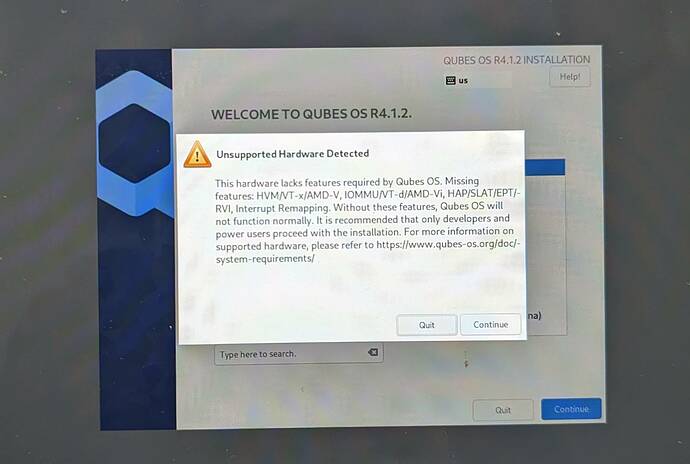Hi there,
I am running MX Linux as my main OS,
and in the VM I want to run QubesOS, for which I am allocating 40GB of the SDD.
Unfortunately, I am encountering a problem at the beginning of the installation process.
Picture below
Quick System Info of the Hardware and MX OS
System: Kernel: 5.10.0-21-amd64 [5.10.162-1] x86_64 bits: 64 compiler: gcc v: 10.2.1
parameters: BOOT_IMAGE=/vmlinuz-5.10.0-21-amd64
root=UUID=<filter> ro quiet splash
Desktop: Xfce 4.18.1 tk: Gtk 3.24.24 info: xfce4-panel wm: xfwm 4.18.0 vt: 7
dm: LightDM 1.26.0 Distro: MX-21.3_x64 Wildflower January 15 2023
base: Debian GNU/Linux 11 (bullseye)
Machine: Type: Laptop System: Dell product: Latitude 7480 v: N/A serial: <filter> Chassis:
type: 10 serial: <filter>
Mobo: Dell model: N/A serial: <filter> UEFI-[Legacy]: Dell v: 1.19.0 date: 07/26/2020
Battery: ID-1: BAT0 charge: 16.4 Wh (52.7%) condition: 31.1/60.0 Wh (51.9%) volts: 7.2 min: 7.6
model: SMP DELL DM3WC64 type: Li-poly serial: <filter> status: Discharging
CPU: Info: Dual Core model: Intel Core i7-7600U bits: 64 type: MT MCP arch: Amber/Kaby Lake
note: check family: 6 model-id: 8E (142) stepping: 9 microcode: F0 cache: L2: 4 MiB
flags: avx avx2 lm nx pae sse sse2 sse3 sse4_1 sse4_2 ssse3 vmx bogomips: 23199
Speed: 1420 MHz min/max: 400/3900 MHz Core speeds (MHz): 1: 1420 2: 1421 3: 1405
4: 1424
Vulnerabilities: Type: itlb_multihit status: KVM: VMX disabled
Type: l1tf mitigation: PTE Inversion; VMX: conditional cache flushes, SMT vulnerable
Type: mds mitigation: Clear CPU buffers; SMT vulnerable
Type: meltdown mitigation: PTI
Type: mmio_stale_data mitigation: Clear CPU buffers; SMT vulnerable
Type: retbleed mitigation: IBRS
Type: spec_store_bypass
mitigation: Speculative Store Bypass disabled via prctl and seccomp
Type: spectre_v1 mitigation: usercopy/swapgs barriers and __user pointer sanitization
Type: spectre_v2
mitigation: IBRS, IBPB: conditional, RSB filling, PBRSB-eIBRS: Not affected
Type: srbds mitigation: Microcode
Type: tsx_async_abort mitigation: Clear CPU buffers; SMT vulnerable
Graphics: Device-1: Intel HD Graphics 620 vendor: Dell driver: i915 v: kernel bus-ID: 00:02.0
chip-ID: 8086:5916 class-ID: 0300
Device-2: Microdia Integrated_Webcam_HD type: USB driver: uvcvideo bus-ID: 1-5:2
chip-ID: 0c45:6715 class-ID: 0e02
Display: x11 server: X.Org 1.20.11 compositor: xfwm4 v: 4.18.0 driver:
loaded: modesetting unloaded: fbdev,vesa display-ID: :0.0 screens: 1
Screen-1: 0 s-res: 2560x1440 s-dpi: 96 s-size: 677x381mm (26.7x15.0")
s-diag: 777mm (30.6")
Monitor-1: eDP-1 res: 2560x1440 hz: 60 dpi: 210 size: 309x174mm (12.2x6.9")
diag: 355mm (14")
OpenGL: renderer: Mesa Intel HD Graphics 620 (KBL GT2) v: 4.6 Mesa 20.3.5
direct render: Yes
Audio: Device-1: Intel Sunrise Point-LP HD Audio vendor: Dell driver: snd_hda_intel v: kernel
alternate: snd_soc_skl bus-ID: 00:1f.3 chip-ID: 8086:9d71 class-ID: 0403
Sound Server-1: ALSA v: k5.10.0-21-amd64 running: yes
Sound Server-2: PulseAudio v: 14.2 running: yes
Network: Device-1: Intel Ethernet I219-LM vendor: Dell driver: e1000e v: kernel port: f040
bus-ID: 00:1f.6 chip-ID: 8086:15d7 class-ID: 0200
IF: eth0 state: down mac: <filter>
Device-2: Intel Wireless 8265 / 8275 driver: iwlwifi v: kernel modules: wl port: f040
bus-ID: 02:00.0 chip-ID: 8086:24fd class-ID: 0280
IF: wlan0 state: up mac: <filter>
Bluetooth: Device-1: Intel Bluetooth wireless interface type: USB driver: btusb v: 0.8
bus-ID: 1-7:3 chip-ID: 8087:0a2b class-ID: e001
Report: hciconfig ID: hci0 rfk-id: 3 state: up address: <filter> bt-v: 2.1 lmp-v: 4.2
sub-v: 100 hci-v: 4.2 rev: 100
Info: acl-mtu: 1021:4 sco-mtu: 96:6 link-policy: rswitch hold sniff
link-mode: slave accept service-classes: rendering, capturing, object transfer, audio
Drives: Local Storage: total: 476.94 GiB used: 7.63 GiB (1.6%)
SMART Message: Unable to run smartctl. Root privileges required.
ID-1: /dev/nvme0n1 maj-min: 259:0 vendor: A-Data model: SX6000PNP size: 476.94 GiB
block-size: physical: 512 B logical: 512 B speed: 31.6 Gb/s lanes: 4 type: SSD
serial: <filter> rev: V9002s16 temp: 29.9 C scheme: MBR
Partition: ID-1: / raw-size: 23.38 GiB size: 22.85 GiB (97.71%) used: 7.34 GiB (32.1%) fs: ext4
dev: /dev/dm-0 maj-min: 253:0 mapped: root.fsm
ID-2: /boot raw-size: 1024 MiB size: 973.4 MiB (95.06%) used: 187.1 MiB (19.2%)
fs: ext4 dev: /dev/nvme0n1p1 maj-min: 259:1
ID-3: /home raw-size: 444.52 GiB size: 436.47 GiB (98.19%) used: 112.2 MiB (0.0%)
fs: ext4 dev: /dev/dm-2 maj-min: 253:2 mapped: 1.home.fsm
Swap: Kernel: swappiness: 15 (default 60) cache-pressure: 100 (default)
ID-1: swap-1 type: partition size: 7.98 GiB used: 0 KiB (0.0%) priority: -2
dev: /dev/dm-1 maj-min: 253:1 mapped: swap
Sensors: System Temperatures: cpu: 35.5 C mobo: N/A
Fan Speeds (RPM): cpu: 0
Repos: Packages: note: see --pkg apt: 2041 lib: 1032 flatpak: 0
No active apt repos in: /etc/apt/sources.list
Active apt repos in: /etc/apt/sources.list.d/brave-browser-release.list
1: deb [arch=amd64] https://brave-browser-apt-release.s3.brave.com/ bullseye main
Active apt repos in: /etc/apt/sources.list.d/debian-stable-updates.list
1: deb http://deb.debian.org/debian bullseye-updates main contrib non-free
Active apt repos in: /etc/apt/sources.list.d/debian.list
1: deb http://deb.debian.org/debian bullseye main contrib non-free
2: deb http://security.debian.org/debian-security bullseye-security main contrib non-free
Active apt repos in: /etc/apt/sources.list.d/mx.list
1: deb http://nl.mxrepo.com/mx/repo/ bullseye main non-free
Active apt repos in: /etc/apt/sources.list.d/nordvpn.list
1: deb https://repo.nordvpn.com/deb/nordvpn/debian stable main
Active apt repos in: /etc/apt/sources.list.d/signal-xenial-added-by-mxpi.list
1: deb [arch=amd64] https://updates.signal.org/desktop/apt xenial main
Active apt repos in: /etc/apt/sources.list.d/vivaldi.list
1: deb http://repo.vivaldi.com/stable/deb/ stable main
Info: Processes: 251 Uptime: 21m wakeups: 2 Memory: 31 GiB used: 2.41 GiB (7.8%)
Init: SysVinit v: 2.96 runlevel: 5 default: 5 tool: systemctl Compilers: gcc: N/A
alt: 10 Client: shell wrapper v: 5.1.4-release inxi: 3.3.06
Boot Mode: BIOS (legacy, CSM, MBR)
